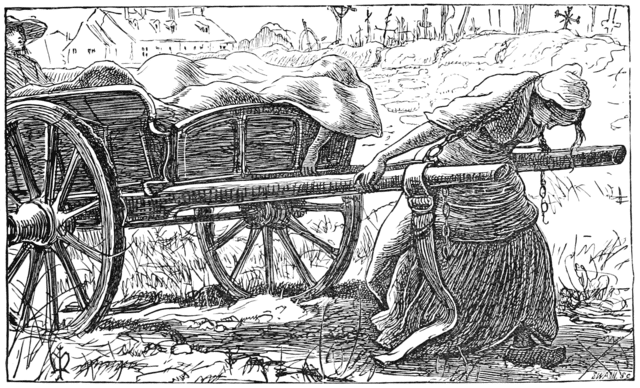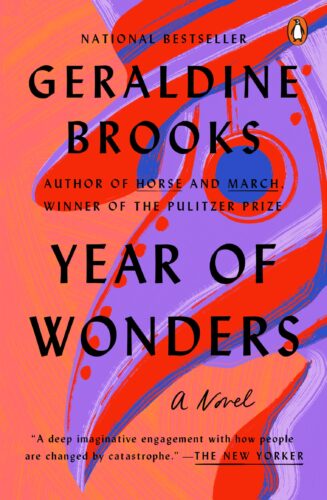Interesting Premise, But Breaks the Historical Mystique
Author: Geraldine Brooks
It’s 1666 and recently widowed Anna Frith is beginning to see hope and possibility. Not only has her new lodger brought some much-needed money into her domicile, but his love of her children, his inappropriately amusing city stories, and the bolts of colorful cloth he uses to weave the latest fashions are slowly drawing her back into the world. Perhaps there is more between them – or could be. Perhaps it is time to let go of grief and embrace life again. But then her boarder dies, horribly, and she doesn’t (can’t) follow through with his instruction to burn all the beautiful cloth. And now the Black Death has come to the village. Anna’s potential lover is the first she has lost to it, but he will not be the last.
I’ll preface this review by saying that I am not a huge Geraldine Brooks fan. Despite her historical settings, her modern sensibilities often ruin the atmosphere for me, casting me out of the time and place that should be shaping the essence of the story. This happened in The Secret Chord, where the Biblical figure of Kind David is not the righteous man of the Bible, but an illicit figure deeply in love with his best friend, embracing and living a gay relationship in a time and place where that would have been beyond impossible. Besides the blatant sacrilege of misrepresenting a Biblical figure, this choice undermined the historical setting which was supposed to be the star. And, despite its good qualities, many of the same issues exist in Year of Wonders.
I was drawn to this tale by Dorsey Armstrong’s lecture sin The Black Death: The World’s Most Devastating Plague where she noted that Year of Wonders accurately depicts the Black Death’s manifestation. I enjoyed Armstrong’s lectures, and her praise for Year of Wonders made me decide to give Brooks another try.
This story is both successful and flawed, in equal parts. The plague itself is a staring, gruesome character. It’s almost clinical, the way we see the progression of the disease (on occasions). The story is inspired by a real-life village, Eyam, where the pastor convinced the sickening population to choose a self-enforced quarantine; this village was supported by the lords around them, who left food and necessities in a clearing.

Illustration from Once a Week magazine, accompanying a ballad about a medieval plague in the Elliant district of Brittany
In the book, the fictional pastor, Michael Mompellion, is based on the real one. Mompellion and his kindly, weak wife Elinor become close to Anna. Elinor and Anna work together to attempt to treat the sick. When a local “witch” dies, the two take over her house, learning the art of treating with herbs and poultices, and with easing the pain of the dying. As Anna loses everything, including her children, she gains this friend, and becomes one with the pastor’s household, until tragedy strikes again, and everything shifts.
The story up until this point is strong, especially from a historical perspective. As Armstrong noted in her lectures, while we perceive people in the Middle Ages as being entirely ignorant, that was not so. This story gives a more circumspect view, showing that these people were just as intelligent, if not as medically knowledgeable, as we are now. The idea of self-quarantine shows this fully, as does Anna’s lodger’s understanding that the plague was brought in on his imported fabric, which should then be burned.
However, there is the usual hysteria, and in trying to throw everything in, we have plague, self-flagellants, and a witch hunt, all in one. It’s a bit much, as though the author is trying to shove in absolutely everything that happened over hundreds of years in the span of a few weeks. It’s too much catastrophe for one village; surely the plague itself would have been enough.
And then there is Anna, with her modern sensibilities. Elinor and Anna’s understanding of the “witches” is unlikely at this time period, and their general acceptance even more modern than will fit the strictures of the story. They are all together too perfect, too tolerant, and too infallible to be entirely believable. Anna, who was formerly just a house servant, is too much of a dogged heroine, and the Mompellions are altogether too even keeled during such a catastrophic event . . .
. . . until the second half of the book where all established characterization is dramatically upended, and former hero/minister Mompellion becomes a total monster in a plot switch that is nonsensical and unnecessary. This twist ruins all the “good” characters and leads readers toward a singularly ridiculous conclusion with Anna fleeing halfway across the world to land as a woman doctor in a Muslim country. What . . . what the. . . what did I just read?
Overall, this book is interesting but deeply flawed. It’s an enjoyable read, for what it is, but I never believed that we were in this place, at this time. As with other books by Brooks that I have previously read, there is too much modern judgement and sensibilities and too many outlandish escapes and thriller-esque twists to sit well with audiences. I certainly didn’t hate Year of Wonders, but it hasn’t changed my mind about Brooks’ stories.
– Frances Carden
Follow my reviews on Twitter at: https://twitter.com/xombie_mistress
Follow my reviews on Facebook at: https://www.facebook.com/FrancesReviews
- Book Vs Movie: The Shining - April 6, 2020
- Thankful For Great Cozy Mysteries - December 13, 2019
- Cozy Mysteries for a Perfect Fall - October 20, 2019




